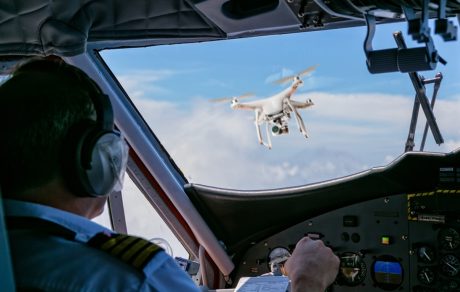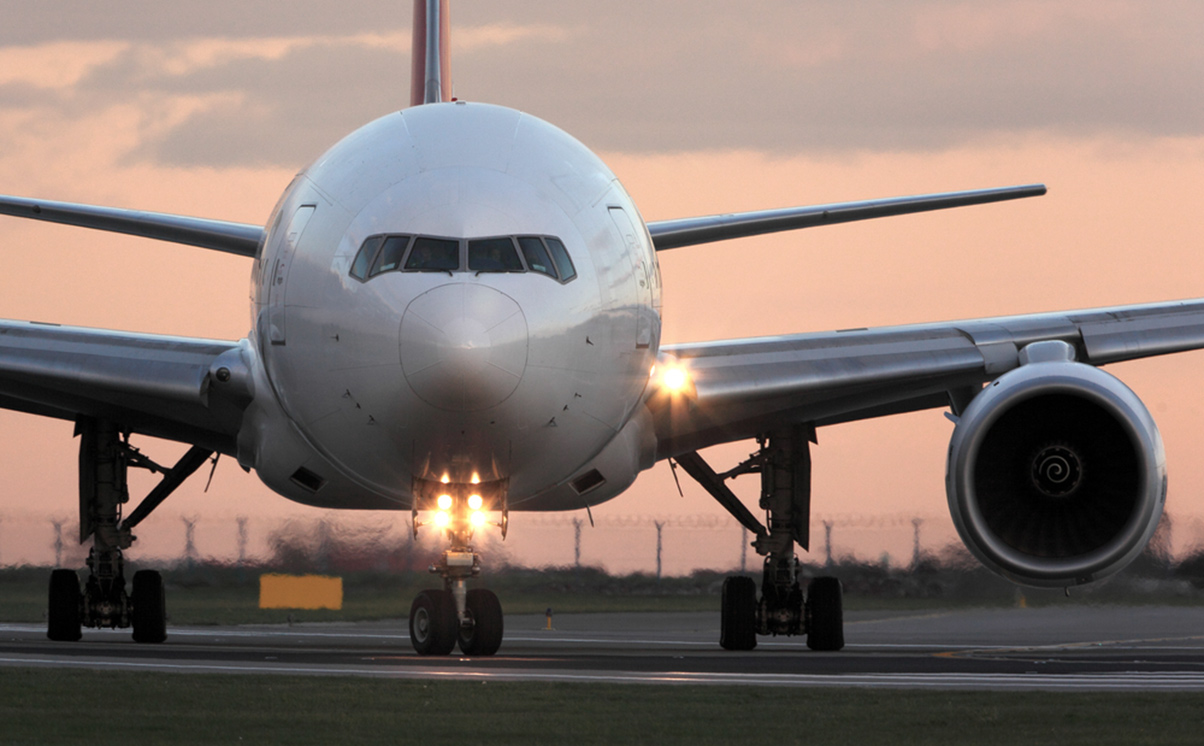(read time: 19 mins)
There is an increased likelihood of a drone-aircraft collision occurring in the near future. In his article Flight Risk, in PI Focus, Peter Neenan, Partner in the Aviation department outlines the potential ramifications of such a collision.
In the next few years, there is a substantial likelihood that a drone and an aircraft will collide, and we must prepare ourselves for this eventuality. This article considers the practical and legal ramifications should such a collision occur.
In 2017, the UK Airprox Board reported 92 near-misses between drones and aircraft. This was up from 70 in 2016, and 28 in 2015.
These Airprox reports are made when, in the opinion of a pilot or air traffic services personnel, the safety of an aircraft was at risk as a result of the relative position or speed of a drone to the aircraft.
In 2017, 29 of those near-misses were described as ICAO Risk Category A incidents. An ICAO risk category A incident is defined as the risk classification for an aircraft proximity incident in which a ‘serious risk of collision’ has existed. It is the highest of the ICAO Risk categories.
In practice, the majority of the Category A incidents involve a proximity of less than 50ft (15m) between the aircraft and the drone. In most cases, the pilots of the aircraft state that there was insufficient time to take any evasive action.
Perhaps more troubling is the altitude at which these near misses have occurred. In all but one of the 29 Risk Category A incidents, the drone was being operated substantially higher than 400ft.
Historically, while best practice as set out in the drone code recommended flight below 400ft, only drones greater than 7kg were firmly prohibited from flying over 400ft under the Air Navigation Order 2016.
Flights for drones weighing under 7kg (which would include the majority of hobbyist drones – by way of comparison, a DJI Phantom 3 weighs 1.2kg and can lift approximately 1kg at most), had no explicit height restriction, except for a requirement that the person operating the drone maintain direct, unaided (ie no binoculars) visual contact with the aircraft (visual line of sight – VLOS).
Direct unaided visual contact with a drone is an undefined distance and will depend on weather conditions. However, in the CAA’s guidance for the First Person Viewing exemption ORS4 No.1226 (no longer in force), reference is made to 1,000ft as an implied ceiling for maintaining visual contact with a drone. In practice, the actual height at which visual contact can be maintained may well be less, and closer to 400ft.
In the 2017 Airprox data, in most cases, the drones were being operated between 1,000 and 3,000ft (14 of 29), with more incidents of drones being operated over 3,000ft (11 of 29) than under 1,000ft (4 of 29). In several cases, the drones were being operated as high as 6,000 to 7,000ft (4 of 29).
In the vast majority of the cases, the investigators concluded that the drone was being operated well beyond practical visual line of sight, and given the implied visual ceiling in ORS4 No.1226, it would be reasonable to assume that at least 25 of the 29 instances were beyond visual line of sight, and being flown in breach of the ANO. Many were being operated in the vicinity of airports, on the path of an airfield approach (23 of 29).
The 2018 amendment to the Air Navigation Order 2016
On 30 July 2018, certain provisions of the Air Navigation (Amendment) Order 2018 (the ‘ANO Amendment’) came into force, which varied existing provisions of the Air Navigation Order 2016 (the ‘ANO’).
Critically for the present purposes, the ANO Amendment provides a concrete limit of 400ft for the operation of drones (unless permission of the Civil Aviation Authority has been obtained).
Further, it precludes the operation of drones below 400ft within one kilometre of the boundary of an airfield that has air traffic control (or a flight information service) unless permission of the CAA has been obtained. It precludes the operation of drones within the boundary of an airfield that does not have air traffic control (or a flight information service), unless permission of the operator of the aerodrome has been obtained.
Is this enough, and will it reduce the likelihood of an aircraft-drone collision?
The data from 2017 shows that of the 29 Category A incidents, at least 25 were beyond visual line of sight (86%), and therefore in breach of the ANO.
In the case of such breaches, the person operating the drone is guilty of an offence and liable to a fine of £2,500 pursuant to Article 265(6) of the ANO.
Had one of the drones impacted an aircraft, and were the operator found to have recklessly or negligently permitted the drone to endanger any person or property under Article 241, then they would be guilty of an offence that could potentially be punishable by imprisonment for up to two years (plus a possible fine). Yet such potential punishments have not dissuaded drone operators from breaching the ANO to date. As such, it remains to be seen whether greater numbers of drone operators will comply with the ANO (as amended), given the clarity of the new requirements.
There is a separate question regarding whether those requirements are enough; in particular, the new requirement that drones not be operated within one kilometre of the boundary of an airfield with an ATC unit.
At Heathrow, by way of example, the airfield boundary is located 678m from the runway threshold of Runway 09. The approach angle for Runway 09 is 3.2 degrees.
Simple trigonometry indicates that one kilometre from the runway boundary (at the extent of the new ANO Amendment flight prohibition), an aircraft on the approach to runway 09 will be at an altitude of approximately 307ft (93.8m): within the limits of lawful drone operation.
In fact, it is only at a distance of 2.18km from the runway threshold (ie. a further half kilometre from the airfield boundary) that there is no longer a theoretical risk of drone and aircraft collision (if the drone operator complies with the ANO).
It is not clear why the ANO Amendment did not simply provide for no drone flight within two kilometres of an airfield boundary; at this distance, there is substantially greater certainty that a drone-aircraft collision will not occur. There is no obvious reason why a drone would need to be operated at this close proximity to an airfield.
Further, it is clear from the 2017 Airprox Category A data that the greatest probability of drone-aircraft collision occurs in the vicinity of an airfield. One factor which it is hoped may encourage compliance with the ANO is the new requirement for drone pilots to receive an acknowledgment of competency and register as a Small Unmanned Aircraft (SUA) operator (ANO Amendment Articles 94C-94G).
The registration number of the SUA operator needs to be displayed on the drone they are operating. Failure to register as an SUA operator or to receive an acknowledgment of competency renders the operator guilty of an offence and liable to a fine of £1,000 pursuant to Article 265(5) of the ANO. This requirement applies for drones over 250g, and will not come into force until 30 November 2019.
The new requirement follows the position already taken by many countries, including the US.
In the US, the Small UAS Rule (14 CFR Part 107) came into effect on 29 August 2016 and requires a similar remote pilot certificate and registration of the drone (note: registration of the drone rather than the operator).
Drones may still be operated purely for recreational use pursuant to the Special Rule for Model Aircraft (14 CFR Part 101.43) without obtaining the remote pilot certificate; however, registration of the drone is still necessary and it is a breach of the Special Rule for Model Aircraft to operate a drone within five miles (eight km) of an airport, or in any manner that interferes with aircraft.
The FAA continues to pursue identified breaches, where possible. The largest of those fines, for commercial drone operation in breach of airspace regulations and aircraft operating rules over New York City and Chicago, involved a proposed civil penalty of $1.9m; this ultimately settled for $200k (with an additional $300k payable in the event of repeat breaches or violations of the settlement agreement).
Has the implementation of these rules and the prosecution of drone operators had any effect on drone near-misses in the US?
Similar to the UK Airprox Board, in the US the FAA reports UAS sightings in the vicinity of airports and around airplanes and helicopters.
In 2015, prior to the implementation of Small UAS Rule, there were 1,210 sightings. That increased by 45% in 2016 to 1,762, the year in which the UAS Rule came into effect. The following year, with the rule in full effect, this increased again by 20% to 2,121 sightings. In the first two quarters of 2018, there has been a 16% increase from the first two quarters of 2017. (It is necessary to compare quarters as the data suggests, somewhat unsurprisingly, that the highest number of sightings occur in the second and third quarters of the year when the weather is better.)
That is not to say that fear of prosecution from breaches of the Special Rule for Model Aircraft or the Small UAS Rule has not had any effect, but the numbers of near-misses, and therefore the probability of a collision, continues to increase despite implementation of these measures.
Collision impact
In risk assessment terminology, a risk is defined as the multiplication of likelihood and impact.
The 2017 Airprox data confirms that the likelihood of a drone-aircraft collision is greatest (relatively) in the vicinity of an airfield. It is therefore necessary to consider the impact of a collision.
In June 2017, the UK government released a report commissioned by the Military Aviation Authority, the British Airline Pilots Association and the Department of Transport considering the potential impact of a drone-aircraft collision.
The report focuses on impacts with helicopter tail rotors and with windscreens of a variety of aircraft types. The report has been criticised by some for the oversimplification of the modelling which, the critics say, causes results that may be inaccurate and tend towards more severe damage than would be seen in practice.
Nevertheless, the results of the study are perhaps not surprising: heavier drones cause more damage; the construction of the drone plays a significant role in the impact (with drones with exposed metallic parts causing greater damage than those with “impact-absorbing” plastic covering their metallic components); non-bird strike resistant windscreens and helicopter tail rotors have limited resilience to the impact of a drone.
For airliners, critical windscreen damage could occur during an impact, but generally only with the higher weight of drones (in this study 4kg). That is a substantial drone, but it is not outside the realms of possibility that a hobbyist would be operating such a drone. By way of example, the DJI Spreading Wings S900, while perhaps intended for professional photography, can still be purchased by a hobbyist and weighs 3.3kg, with a payload capacity of a further 4.9kg. There are other drones with similar specifications.
The class of aircraft at greatest risk of critical damage in a drone collision are those without birdstrike certified windscreens. In addition to helicopters without birdstrike certified windscreens, this means most general aviation aircraft as well.
It is noteworthy that the ANO Amendment provides less protection to general aviation aircraft operating out of airfields without air traffic control or a flight information service.
A drone operator may legitimately operate their drone up to 400ft up to the boundary of such an airfield, with even the smaller drones (400g–1.2kg) likely to cause structural failure of the windscreen and/or penetration of the drone into the cockpit in the event of an impact.
While the frequency of aircraft operating into these airfields is lower than for an airfield with an air traffic control service, the severity of the impact is substantially higher. It is therefore somewhat surprising that the rules have been relaxed for operations around such airfields.
In addition to the UK windscreen impact study, other studies have been undertaken to consider the impact of drone ingestion into an engine of an airliner.
One such study has been undertaken by the FAA’s Center of Excellence for UAS Research. The study, entitled, ‘UAS Airborne Collision Severity Evaluation’ and released in November 2017, uses finite element analysis to model drone ingestion into a midsize business jet engine. There is no attempt at undertaking practical experimentation and the study relies instead solely on mathematical modelling. The drones used do not weigh as much as the largest drones considered in the UK report (the drones used in the study are a finite element analysis model of the DJI Phantom 3 weighing 2.68lbs/1.2kg and a finite element analysis model of the Precision Hawk Lancaster Hawkeye Mark III weighing 4lbs/1.8kg). The relevance of this is simply that larger drones are likely to result in greater damage.
Despite this, the report analyses drone ingestion at varying speeds of the engine consistent with different flight stages. For the parameters used, there is no model that results in containment failure in the engine, but several scenarios that result in material loss or total loss of fan blades, and damage or penetration of the nose cone.
The report finds that the most dangerous phase of flight for drone ingestion is during takeoff.
A contained failure of an engine by drone ingestion (or any other reason) in a twin-engine aircraft should not be catastrophic unless mishandled (and it is highly unlikely that more than one drone would be ingested leading to multiple engine failure). It does, however, place greater stress on the pilot, and there have been numerous examples of crews mishandling engine failures. An example is the TransAsia Airways Flight 235 accident, where the pilot shut down the wrong engine on the ATR 72 after engine flameout of the other engine.
Legal ramifications following collision
Whether by engine ingestion or windscreen penetration, if a drone collides with an aircraft and the pilot is not able to manage the emergency, the aircraft will crash. Such a crash could result in severe injuries or fatalities to the crew and passengers.
In the UK, if the flight is being conducted as a commercial operation (flight for reward or gratuitous carriage by an air transport undertaking) the Montreal Convention will govern the liability of the airline.
This will happen directly for international carriage, or as a consequence of EU 889/2002 for domestic carriage.
Under Article 21 of the Montreal Convention, the liability of the airline is strict up to 113,100 Special Drawing Rights (c. £123,000), with an assumption of fault and reversed burden of proof thereafter.
In practice in ordinary aviation accidents, it is extremely difficult for an airline to limit its liability. In almost all cases there will be a reasonable argument that the airline or the pilot was in some way negligent, or was guilty of some wrongful omission that might have averted the accident.
For example, in the Malaysia Airlines Flight MH17 accident, it could be argued that the airline’s choice of routing and inadequacy of their risk assessment process exposed the aircraft to the risk of being shot down.
This channelling of liability through the airline makes sense: the basis of liability under the Montreal Convention is an insurance regime that supports the imposition of presumed operator liability, in circumstances where they will on most occasions be partially or fully responsible and have insurance to cover that risk (with premiums charged appropriately).
Drones represent a new issue. As set out in the first paragraph, given the size of drones and the speed of closure between the drone and the aircraft, pilots will rarely have sufficient time to take evasive action.
The risk of the drone collision occurs because the drone is being operated on the standard flight route of the aircraft (whether on departure or approach).
In the event of an accident, defendant airlines might legitimately argue that their liability should be limited to 113,100 SDR in circumstances where they did nothing wrong. The airline and its insurers might justifiably be aggrieved that they should have to pay even 113,100 SDR, but there is a right of recourse against responsible third parties under Article 37 of the Montreal Convention for those airlines and their insurers to seek recompense of that first 113,100 SDR.
In accidents resulting in serious injury or death, claims of passengers or their dependents will invariably exceed 113,100 SDR. So, who should the victims pursue for the excess of their claims above 113,100 SDR, and the airlines pursue for that first 113,100 SDR?
In all likelihood, the person primarily responsible for the accident will be the drone operator, particularly where they are operating the drone in breach of the Air Navigation Order 2016. By way of reminder, in 2017, at least 86% of Risk Category A nearmisses were in breach of the ANO. Were the present amended ANO in force at that time, this would have increased to 97%. Certainly 97% were in breach of best practice, as set out in the drone code.
It is reasonable to assume that the operator of a drone that is in breach of the Air Navigation Order would be a hobbyist, rather than a commercial operator, as one would expect a commercial operator to have a sufficiently developed safety management system to avoid such a scenario.
There is no current requirement for hobbyists to obtain insurance for operation of their drones in the UK (nor in the US where the FAA lacks jurisdiction to mandate the purchase of liability insurance, but the FAA does encourage drone pilots to evaluate their existing policies).
However, a number of companies have begun to offer drone insurance on a pay-as-you-fly basis for recreational drone users.
Those policies (perhaps unsurprisingly) require users to confirm that flight will be in accordance with the Air Navigation Order or the drone code. Any flight that breaches the Air Navigation Order will result in the policy being deemed invalid with cover avoided.
Given historical breaches of the Air Navigation Order by drone pilots in near-miss incidents, there is substantial likelihood that the hobbyist will breach the ANO and, therefore, have no valid insurance cover.
Even if the collision occurs in circumstances where there is not a breach of the ANO, some drone policies additionally do not cover damage caused by the negligent behaviour of the drone operator. In such circumstances, it is difficult to see how a claim could succeed against a drone operator and the insurance still actually provide cover, since the basis of any claim against a drone operator would be negligence, and that would invalidate the insurance.
Any action would therefore need to be brought against the assets of the drone operator, which is both unpleasant and unlikely to result in sufficient sums to cover the aggregate value of the claims of a plane full of passengers or their dependents.
Any action against the CAA for negligently setting the altitude and airport proximity limits discussed above faces difficulty, particularly in circumstances where the drone operator breached those limits, in any event.
Perhaps a claim against the drone manufacturer? The maximum service ceiling for most if not all drones is substantially higher than visual line of sight. By way of example, the DJI Phantom 3 mentioned throughout this article has a service ceiling of nearly 20,000ft (6,000m)!
One might frame an argument that the design is defective because it lacks technology that imposes a service ceiling on operation. Given that alternative technology is available to impose such a limit, the cost of this safer design would be minimal, and there is no obvious benefit in the drone being able to reach such substantial heights given that operation at that altitude will be unlawful.
Of course, that altitude limit might not be the same in some jurisdictions. The CAA could give permission for higher flight, and one could foresee an analogous counter-argument that cars have the capacity to travel substantially faster than the speed limit. It is accepted, however, that the operation of a car above the speed limit is the driver’s choice, and any accident resulting from that operation is his negligence, rather than the manufacturer’s defective design.
In the absence of an alternative deep-pocketed defendant, airline insurers will be faced with no viable recourse, and injured passengers or dependent families will be faced with insufficient compensation and future financial insecurity.
What can be done? One solution might be the creation of an MIB (Motor Insurers’ Bureau) for drone-aircraft collisions, perhaps DIB (Drone Insurers’ Bureau). The MIB provides insurance coverage in the case of uninsured or untraced driver, funded as a cost (c. £30 per policy) included within insured drivers’ premiums. Such a strategy might work for drones as well, but it needs consideration and development before we see the first airliner taken down by a drone. However, it is anticipated that this will emerge as a cure, after a problem, rather than prevention beforehand to anticipate this difficulty.
The situation is even bleaker when one considers private aircraft flights and damage to the aircraft itself.
In relation to private aircraft flights, without the protection of the strict liability regime of the Montreal Convention, any claim would only succeed with a foundation of negligence against a party.
For the reasons given above, it is improbable that there would be a firm basis to allege negligence against the pilot, and a lack of insurance against the drone operator. Likewise, in relation to hull losses following the downing of an aircraft, or structural damage to an aircraft or an engine following a drone collision, while insurance would be likely to cover the airline for their losses, the insurer might seek to exercise their subrogation rights but lack a viable insured defendant for any such action.
In the alternative or in addition to a legal/insurance solution with the creation of the DIB, a risk-reducing solution might lie in technology, with various companies working on drone tracking software.
DJI have unveiled a drone tracking system called Aeroscope, which can be installed into a moving object (like an aircraft) to track drones in the vicinity of the aircraft.
At present, however, it only tracks DJI drones and has a short range. Alternatively, Vodafone has built a tracking system that it believes supports geo-fencing and the ability to override a drone operator’s control to alter the drone’s flight path or force it to land. Unfortunately, at present, the system only has a 50m accuracy.
Those drone tracking systems, if successfully implemented, and coupled with firm prosecution of culpable parties under the ANO, may achieve the desired result in reducing the risk of a collision.
Ultimately, technology continues to grow at pace, drone sales continue to soar and instances of near-misses continue to increase – despite attempts to force compliance with safe practice. It is critical that a safety net is created through risk-reducing technology and/or insurance protection, to try to mitigate the potential risk and damage caused by a drone collision.
This article first appeared in the October 2018 edition of PI Focus. Please click here to read the original (subscription required).
You can find further information regarding our expertise, experience and team on our Aviation pages.
If you require assistance from our team, please contact us or alternatively request a call back from one of our lawyers by submitting this form.
Subscribe – In order to receive our news straight to your inbox, subscribe here. Our newsletters are sent no more than once a month.




